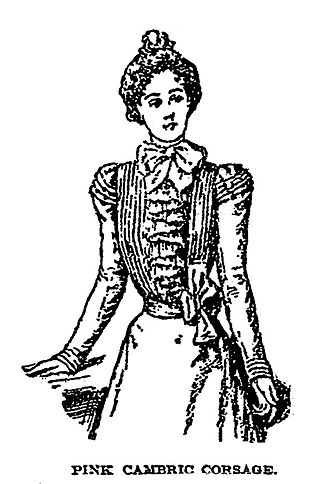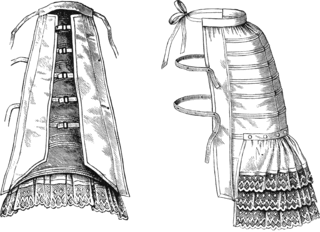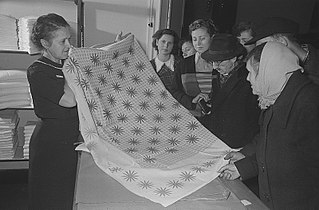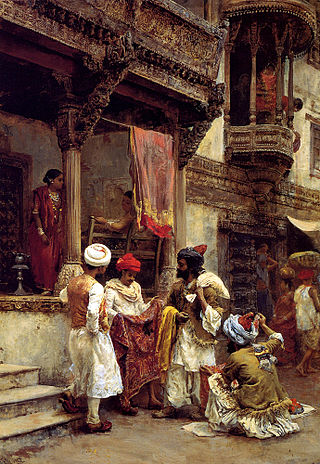Related Research Articles

Calico is a heavy plain-woven textile made from unbleached, and often not fully processed, cotton. It may also contain unseparated husk parts. The fabric is far coarser than muslin, but less coarse and thick than canvas or denim. However, it is still very cheap owing to its unfinished and undyed appearance.

Linen is a textile made from the fibers of the flax plant.

Muslin is a cotton fabric of plain weave. It is made in a wide range of weights from delicate sheers to coarse sheeting. It gets its name from the city of Mosul, Iraq, where it was first manufactured.
Lawn cloth or lawn is a fine plain weave textile, made with fine combed cotton. Terms also used include batiste and nainsook. Originally the name applied to plain weave linen, and linen lawn is also called "handkerchief linen". The term lawn is also used in the textile industry to refer to a type of starched crisp finish given to a cloth product. The finish can be applied to a variety of fine fabrics, prints or plain.
Calendering of textiles is a finishing process used to smooth, coat, or thin a material. With textiles, fabric is passed between calender rollers at high temperatures and pressures. Calendering is used on fabrics such as moire to produce its watered effect and also on cambric and some types of sateens.

Cambric or batiste is a fine dense cloth. It is a lightweight plain-weave fabric, originally from the commune of Cambrai, woven greige, then bleached, piece-dyed, and often glazed or calendered. Initially it was made of linen; from the 18th and 19th centuries the term came to apply to cotton fabrics as well. Chambray is the same type of fabric, with a coloured warp and white filling; the name "chambray" replaced "cambric" in the United States in the early 19th century.

Dimity is a collective term for figured cloths of harness loom decorated with designs and patterns. It is a strong cotton cloth with various stripes and illustrations. It is bleached or washed after looming, less often dyed, unlike fustian, which is usually dyed.
Dowlas was a strong coarse linen cloth of the 16th and 17th centuries, and initially, it was manufactured in Brittany. In the 18th century the fabric was also produced in England and Scotland. Dowlas was identical to sailcloth. The cloth was also imitated in cotton for the same use.

Linsey-woolsey is a coarse twill or plain-woven fabric woven with a linen warp and a woollen weft. Similar fabrics woven with a cotton warp and woollen weft in Colonial America were also called linsey-woolsey or wincey. The name derives from a combination of lin and wool. This textile has been known since ancient times; known as shatnez (שַׁעַטְנֵז) in Hebrew, the Torah and hence Jewish law explicitly forbade wearing it.

Plain weave is the most basic of three fundamental types of textile weaves. It is strong and hard-wearing, and is used for fashion and furnishing fabrics.

Cloth of gold or gold cloth is a fabric woven with a gold-wrapped or spun weft—referred to as "a spirally spun gold strip". In most cases, the core yarn is silk, wrapped (filé) with a band or strip of high content gold. In rarer instances, fine linen and wool have been used as the core.
The manufacture of textiles is one of the oldest of human technologies. To make textiles, the first requirement is a source of fiber from which a yarn can be made, primarily by spinning. The yarn is processed by knitting or weaving, which turns yarn into cloth. The machine used for weaving is the loom. For decoration, the process of colouring yarn or the finished material is dyeing. For more information of the various steps, see textile manufacturing.
Mercery (from French mercerie, meaning "habderdashery" or "haberdashery" initially referred to silk, linen and fustian textiles among various other piece goods imported to England in the 12th century. Eventually, the term evolved to refer to a merchant or trader of textile goods, especially imported textile goods, particularly in England. A merchant would be known as a mercer, and the profession as mercery.
Decatising or decatizing, also known as crabbing, blowing, and decating, is the process of making permanent a textile finish on a cloth, so that it does not shrink during garment making. The word comes from the French décatir, which means to remove the cati or finish of the wool. Though used mainly for wool, the term is also applied to processes performed on fabrics of other fibers, such as cotton, linen or polyester. Crabbing and blowing are minor variations on the general process for wool, which is to roll the cloth onto a roller and blow steam through it.

The textile bleaching is one of the steps in the textile manufacturing process. The objective of bleaching is to remove the natural color for the following steps such as dyeing or printing or to achieve full white. All raw textile materials, when they are in natural form, are known as 'greige' material. They have their natural color, odor and impurities that are not suited to clothing materials. Not only the natural impurities will remain in the greige material, but also the add-ons that were made during its cultivation, growth and manufacture in the form of pesticides, fungicides, worm killers, sizes, lubricants, etc. The removal of these natural coloring matters and add-ons during the previous state of manufacturing is called scouring and bleaching.

Napery is linen used for household purposes, such as table linen. Historically it was the office in a medieval household responsible for the washing and storage of these items. It was headed by a naperer. This office worked closely together with the offices of the laundry and the ewery, and the three could be concurrent in smaller households.
Holland cloth, or simply Holland is a plainwoven or dull-finish linen used as furniture covering or a cotton fabric made more or less opaque by a glazed or unglazed finish. Originally the name was applied to any fine, plainwoven linens imported from Europe, and particularly from the Netherlands.

Dornix, also known as dornicks and darnacle, is a wool and linen fabric, first used in the 16th century.

Mashru is a woven cloth that is a blend of silk and cotton. It was historically a hand-woven satin silk fabric variety found in the Indian subcontinent, and its proper use is described in the 16th-century Ain-i-Akbari.
Dukula was an ancient Indian cloth made from the bark of trees. Some contemporary varieties kshauma, netra, and tiritpatta including Dukul were among the fabrics that were comparable to silk. Some sources suggest that Dukula was silk, but actually it was made of bark fiber As a result, it was a fine linen. According to Amarasimha, the word "dukula" was a synonym for "ksauma" (linen)
References
- ↑ MATHEWS, KOLANJIKOMBIL (2017). Encyclopaedic Dictionary of Textile Terms: Four Volume Set. Woodhead Publishing India PVT. Limited. p. 32. ISBN 978-93-85059-66-7.
- ↑ Tortora, Phyllis G.; Johnson, Ingrid (2013-09-17). The Fairchild Books Dictionary of Textiles. A&C Black. p. 8. ISBN 978-1-60901-535-0.
- ↑ Rock, Daniel (1876). Textile Fabrics. Committee of Council on Education. p. 65.
- ↑ Notes and Queries. Oxford University Press. 1904. p. 4.